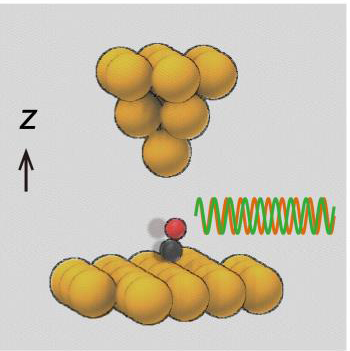

The probe tip of a scanning probe microscope alters the vibrational frequency of the molecule and allows to determine the strength of the bonds.
© Norio Okabayashi – only to be used for this press release.
The CO molecule bonds with the carbon atom to the copper underneath and stands upright on the surface such that the oxygen atom points away from the surface.
The CO molecule can oscillate just like an inverted pendulum. The vibration of a molecule on a surface contains critical information on the bond of the molecule with the surface, which is crucial for understanding surface phenomena and for technologically important processes such as catalysis and epitaxial growth.
As expected, the force that originates from the probe tip (pointed object from above in Figure) changes the vibrational frequencies – attractive forces increase the oscillation frequency, and repulsive interactions decrease the oscillation frequency.
The data revealed that the strength of the bond between carbon monoxide and copper was decreasing as the probe tip pulled the molecule away from the surface, marking the direct observation of the weakening of a single atomic bond by an external influence. The result is important as chemical reactions often evolve by loosening an existing bond before forming a new one.
The result of the research has been reported in “Vibrations of a molecule in an external force field” by N. Okabayashi, A. Peronio, M. Paulsson, T. Arai and F. J. Giessibl in Proceedings of the National Academy of Sciences of the United States of America, April xx, 2018, www.pnas.org












